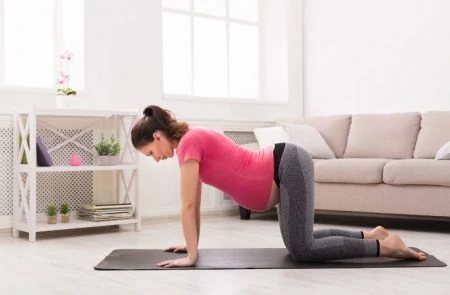Knowing your baby’s position can help you prepare for labor, but it isn’t always something providers teach during prenatal appointments.
Think of belly mapping as a DIY sneak peek into the womb. It’s a technique used to visualize how your baby is lying inside you, empowering you to approach labor with confidence. Plus, it is a fantastic way to bond with your baby and get partners or siblings involved in the pregnancy journey.
Through careful research and our own hands-on experience, we’ve learned the best ways to determine fetal positioning in those final weeks.
In this guide, we will show you how to map your belly so you can understand your baby’s position without waiting for your next doctor’s visit.
Key Takeaways
- Best timing: Belly mapping works best after the 30th week (7 to 8 months) of pregnancy when the baby is large enough to feel distinct body parts.
- Supplies needed: You simply need a quiet space, a non-toxic marker or skin-safe paint, paper, and a doll prop for visualization.
- The method: The process involves locating the hard head, finding the smooth back, and identifying limbs by feeling for kicks and flutters.
- The benefit: Knowing your baby’s position helps you understand labor potential and offers a unique bonding opportunity for the whole family.
Prepare for Your Belly Map
- Wait for week 30: The ideal time to try this is after 30 weeks (1). Before then, your baby is usually too small and moves too frequently to map accurately.
- Ask the pros: It is easier to map your belly right after a check-up. Your doctor or midwife can give you a starting point by telling you the general position.
- Consider your body: Factors like placenta placement (anterior placentas cushion movements), amniotic fluid levels, and abdominal tone impact how well you feel specific parts (2).
- Pick the right moment: Choose a time when your baby is active. You also need a quiet, comfortable environment where you can focus entirely on sensations.
Before you grab your markers, watch this video inspired by Gail Tully, the pioneer of the Belly Mapping method.
Gather Your Supplies
- A baby bump: Obviously, you need your pregnant belly!
- Paper and pen: If you prefer to draw your map on a sheet rather than your skin.
- Skin-safe art supplies: Non-toxic markers, eyeliner, or face paint work well.
- A doll: This acts as a prop to help you visualize where the limbs and head are in relation to your own body.
How To Map Your Belly Step-by-Step
1. Find the Head
Find a quiet space where you can relax without distractions for 15 to 30 minutes. Lie down in a semi-reclined position or prop yourself up slightly on one side. Avoid lying perfectly flat on your back, as this can compress major blood vessels.
Take deep breaths and focus on where the movement is happening.
Using your fingertips, press gently into the upper part of your pelvis, just above the pubic bone. You are looking for something hard and round. If you feel a firm sphere, that is likely the head.
If the area feels round but softer, it is probably the baby’s bottom. Try the “wiggle test” to be sure. If you gently grasp the mass and wiggle it, a head will bob independently. If you wiggle a bottom, the whole body tends to shift (3).
Take Note
Another clue is hiccups. If you feel rhythmic hiccups low in your pelvis, the head is likely down. Once you locate the head, draw a circle on your belly or paper to mark it.
2. Locate the Back
Now that you have the head, hunt for the back. Move your hands up from the head along your uterus. You are feeling for a long, smooth, hard mass.
Depending on the baby’s position, you might feel this clearly on one side. Mark this with a long curved line.
If your belly feels squishy and you feel kicks all over the front, the baby might be “posterior” (spine against your spine). In this case, you might not find a distinct hard line, but you will feel lots of limbs in the front.
3. Visualize with the Doll
You now have a circle for the head and a line for the back. This gives you the basic framework.
Grab your doll and hold it against your stomach to mirror your markings. If the head is low and the back is on your left, position the doll that way. Now, think about the kicks.
Mark the movement spots on your belly with dots or little waves.
- Strong kicks: These are usually feet. If the back is on the left, you should feel kicks on the upper right.
- Little flutters: These are usually hands. If the head is low, you should feel these low in the pelvis.
4. Interpret the Baby’s Position
While “head down” is the goal, the specific angle matters for labor. Here are the common terms you might hear.
- Occiput Anterior (OA): Ideally, the baby is head down with their back facing your belly button. This is the smoothest position for delivery. About 97% of babies turn head down by the time labor begins.
- Occiput Posterior (OP): Often called “sunny side up,” the baby is head down but facing your tummy. This can lead to “back labor” and a longer delivery.
- Breech: The head is up near your ribs. There are variations, such as Frank Breech (legs up) or Footling Breech (feet first).
Head position is not the only factor. The Spinning Babies approach explains how balance in your own body affects the baby’s rotation. Remember, babies move frequently, especially in the second trimester (4).
If you suspect your baby is breech or posterior late in pregnancy, discuss it with your provider. They might suggest specific exercises, chiropractic care, or medical procedures to encourage rotation. Always verify your map with a professional before taking action.
Turn Your Map Into Art
Your belly map is complete! You should see:
- A circle for the head.
- A curved line for the back.
- Symbols representing hands, feet, and movement.
Why not make it a memory? Many moms turn their map into a piece of art, painting the baby on their belly to match the position. It is a fun creative outlet and a great photo opportunity for your pregnancy journal.
Belly Mapping FAQs
The Bottom Line
Belly mapping is more than just a method to predict labor; it is a wonderful exercise to include family members in your pregnancy. Partners can learn to identify the baby’s back, bringing them closer to the reality of the new life coming soon. Even older siblings enjoy drawing on the belly and feeling the kicks.
It can be reassuring if your baby is head down from 32-34 weeks on. However, some moms place a lot of importance on specific positioning. Some positions promote easier labor and vaginal birth, but the baby’s position can change tremendously during labor. As you enter the last trimester, there are some things you can do to promote an easier labor position. Move often, use proper posture, and sit upright. However, the most important intervention is to relax and trust your body. Often, babies flip to the perfect position during labor.
Editor's Note:
Caitlin Goodwin, MSN, RN, CNM









